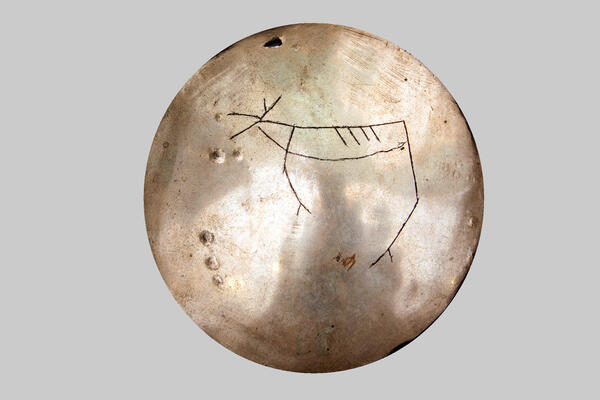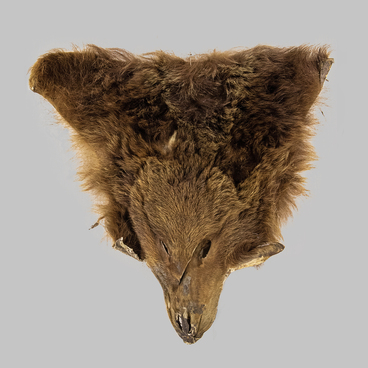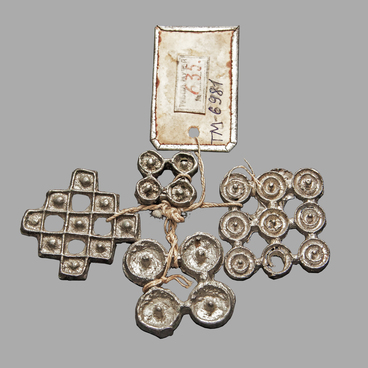The bronze disk, or mirror, an engraved image of a deer got into the Tobolsk Provincial Museum along with other cult items from the Istyatskiy Trove, an archaeological monument related to the Kulay culture. Among the finds, there were 75 flat-curved plaques made of white bronze, two Chinese mirrors, five images of birds, five figures of horsemen, twelve wolf figures, and one openwork pendant with the image of a horned predator.
The oldest mirrors, such as polished bronze disks, were originally common in the Mediterranean. Mirror from the collection of the Tobolsk Museum was among the items of the Istyatskiy Trove found in 1886 by peasant Trifonov 10 kilometers from Istyatskiye Yurty in Tobolsk province. Later, when the curator of the museum Nikolai Lytkin returned to the site of the find, he did not find any additional items there. It was assumed that the territory of the Istyatskiy Trove is the remains of an ancient sacrificial site or sanctuary that belonged to one of the local ancient Ugric tribes.
Metal, mostly bronze mirrors in the culture of the population of the Eurasian steppes and forest steppes appeared long before the Iron Age. In Southern Siberia, the production of local mirrors began in the middle of the 2nd Millennium BC and continued on a large scale during the Karasuk (12th - 8th centuries BC) and Tagar (7th - 3rd centuries BC) periods.
Mirrors with a handle cast together with a disk were common in the East starting from the Bronze Age. The main part of the mirror, according to the terminology proposed by researcher Tatyana Kuznetsova, is characterized by the term ‘disk’, that is, a flat or convex-concave round plate. Many disks that were identified as mirrors or plaques have drawings that are characteristic of the local culture. Most often, these are engravings made with a sharp object, most likely with a knife.
A separate group is formed by engravings on mirrors and plaques of the Istyatskiy Trove, three of which depict horsemen not peculiar to the North of Western Siberia. The other six are engraved with birds of prey with open wings, as well as ‘beavers’, and elk. The iconography of zoomorphic characters is much simpler. Animals either do not lend themselves to identification, or depict conventional ‘beavers’ with a characteristic tail shaded with an oblique grid.
The oldest mirrors, such as polished bronze disks, were originally common in the Mediterranean. Mirror from the collection of the Tobolsk Museum was among the items of the Istyatskiy Trove found in 1886 by peasant Trifonov 10 kilometers from Istyatskiye Yurty in Tobolsk province. Later, when the curator of the museum Nikolai Lytkin returned to the site of the find, he did not find any additional items there. It was assumed that the territory of the Istyatskiy Trove is the remains of an ancient sacrificial site or sanctuary that belonged to one of the local ancient Ugric tribes.
Metal, mostly bronze mirrors in the culture of the population of the Eurasian steppes and forest steppes appeared long before the Iron Age. In Southern Siberia, the production of local mirrors began in the middle of the 2nd Millennium BC and continued on a large scale during the Karasuk (12th - 8th centuries BC) and Tagar (7th - 3rd centuries BC) periods.
Mirrors with a handle cast together with a disk were common in the East starting from the Bronze Age. The main part of the mirror, according to the terminology proposed by researcher Tatyana Kuznetsova, is characterized by the term ‘disk’, that is, a flat or convex-concave round plate. Many disks that were identified as mirrors or plaques have drawings that are characteristic of the local culture. Most often, these are engravings made with a sharp object, most likely with a knife.
A separate group is formed by engravings on mirrors and plaques of the Istyatskiy Trove, three of which depict horsemen not peculiar to the North of Western Siberia. The other six are engraved with birds of prey with open wings, as well as ‘beavers’, and elk. The iconography of zoomorphic characters is much simpler. Animals either do not lend themselves to identification, or depict conventional ‘beavers’ with a characteristic tail shaded with an oblique grid.



